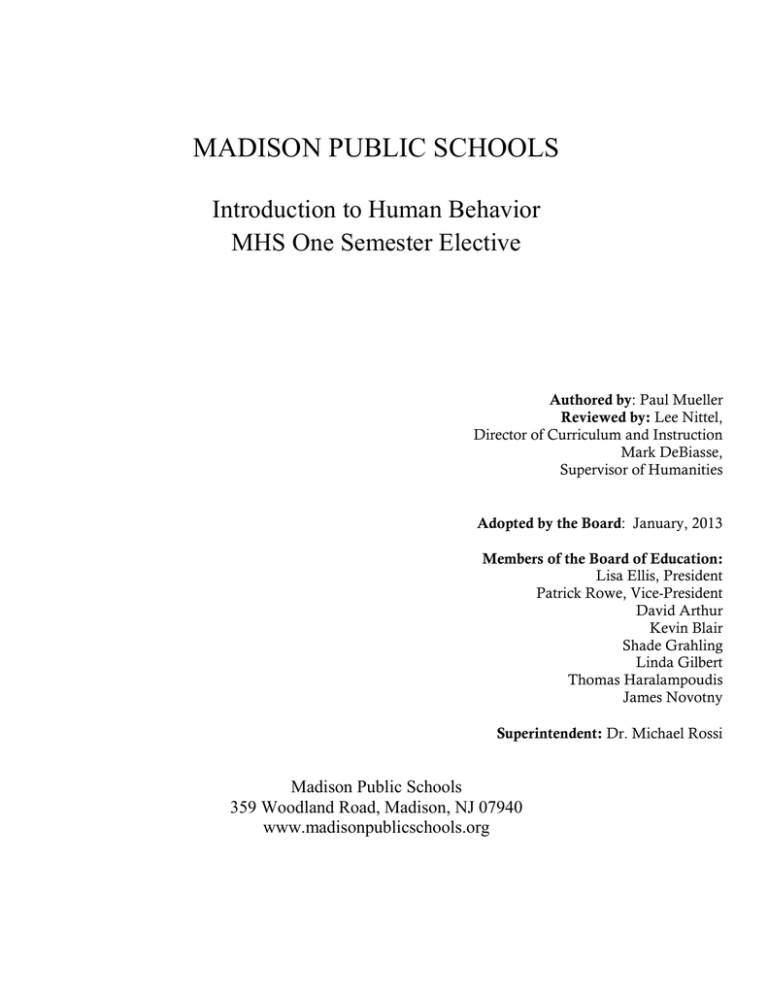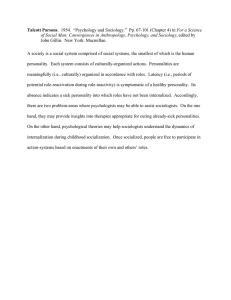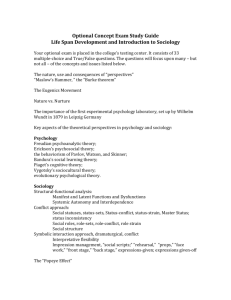MADISON PUBLIC SCHOOLS Introduction to Human Behavior MHS One Semester Elective
advertisement

MADISON PUBLIC SCHOOLS Introduction to Human Behavior MHS One Semester Elective Authored by: Paul Mueller Reviewed by: Lee Nittel, Director of Curriculum and Instruction Mark DeBiasse, Supervisor of Humanities Adopted by the Board: January, 2013 Members of the Board of Education: Lisa Ellis, President Patrick Rowe, Vice-President David Arthur Kevin Blair Shade Grahling Linda Gilbert Thomas Haralampoudis James Novotny Superintendent: Dr. Michael Rossi Madison Public Schools 359 Woodland Road, Madison, NJ 07940 www.madisonpublicschools.org I. OVERVIEW Human Behavior is a one semester course that combines psychology with some sociology to better understand human behavior. This course focuses mostly on psychology (60%) and includes important concepts, theories and principles of sociology. Attention is given to methodology of both social sciences Emphasis is also focused on learning and learning theory and practice from both the individual and societal perspectives. How we develop our personalities will be an important part of this course. Here attention will be placed on individual and environmental factors and how they shape our attitudes, values, beliefs and behaviors. Additionally, this course will study human development through the different ages and stages of life from the psychological and sociological perspective. This course will end with a study of mental illness: types, causes, treatments, and impact on our American society. II. GOALS (Linked to N.J. Content Standards) The following list identifies the N.J. Core Curriculum Content Standards Standard 2.1: Wellness 2.1.12B Growth & Development 2.1.12D. Diseases and Health Conditions. 2.1.12F. Social & Emotional Health Standard 2.2. Integrated Skills 2.2.12A. Communication 2.2.12B. Decision Making 2.2.12F. Health & Services Centers Standard 2.3. Drugs and Medicine 2.3.12A. Medicines 2.3.12B. Alcohol, Tobacco and other drugs 2.3.12C. Dependency Standard 2.4: Human Relationships & Sexuality 2.4.12A. Relationships 2.4.12B. Sexuality Standard 6.1: All students will utilize historical thinking, problem solving and research skills to maximize their understanding of civics, history and economics. Standard 2.1: All students will learn to apply healthy promotion concepts to support healthy active lifestyles. Standard 2.2: All students will use health-enhancing personal, interpersonal, and life skills to support a healthy active lifestyle. III. COURSE OUTLINE A. Introduction to the Course and Science of Psychology and Sociology (2 weeks) 1. 2. 3. 4. 5. 6. 7. B. What are the social sciences? What is psychology and what is sociology? Methods of study used by both. History of psychology and sociology Scientific methods. Methodologies used by both Careers in psychology and sociology. Learning & Culture (4 weeks) 1. 2. 3. 4. 5. 6. 7. 8. C. What is Culture and its component parts? Cultural Universals Subcultures and counterculture Cultural change. Learning: components and practice Four distinct theories of learning The role of memory in learning The American value system and the role of education in it. Personality: from an individual and a social perspective. (3 weeks) 1. 2. 3. 4. 5. 6. D. What is personality? The socialization process. Heredity vs. Environment. Theories of personality Testing personality. Personality disorders Social Organization and Institutions. (3 weeks) 1. Roles and Groups. 2. Social Class and Social Stratification in America. 3. Key institutions: family, education, religion, government & economy. E. Stages in Human Growth and Development. (3 weeks). 1. 2. 3. 4. 5. 6. F. Erickson's Eight Stages of Man theory Childhood Adolescence. Early Adulthood. Middle Adulthood Later Adulthood Emotional & Behavioral Problems (2 weeks). 1. Neurosis ( moderate emotional disorders) 2. Psychosis and forms 3. Treatments and therapies 4. State of mental health in current day America. G. IV. Review for Final Examination (2 days to 1 week). UNIT OBJECTIVES & ACTIVITIES A. Introduction to the Course and Science of Psychology & Sociology 1. Objectives: At the completion of this unit the students will be able to: Define social science and psychology and sociology Describe the methods of study used by psychology & sociology Detail the brief history of both sciences Discuss the role of the scientific method for both sciences. List the degrees and careers possible for psychology and sociology 2. Suggested Activities: Readings: Thomas/Anderson, SOCIOLOGY: The Study of Human Relations. Wade/Tavris, INVITATION TO PSYCHOLOGY. (Text) Exercises: Group work as psychologists and sociologist. Reporting on sociology and psychology in the news Completing a research experiment using scientific method Completing an experimental design experiment. B. Learning and Culture. 1. Objectives: At the completion of this unit the students will be able to: Define culture and detail its component parts and impact Identify and explain cultural universals Detail the meaning of subcultures and countercultures. Describe and give examples of how ideas, the physical environment and assimilation can produce or inhibit cultural change Define learning and explain its component parts. Describe the four theories of learning Apply learning theories to real life learning situations. Describe the three parts of memory and list how they function. Identify ten major American values and how they impact our society. 2. Suggested Activities: Readings: Chapters 5,6 & 7 in Sociology Text and 7,8 & 9 in Psychology Text. Videos: Philip Zimbardo Videos on Psychology: Learning, Thinking & Memory. "Culture & Conflict Today" Activities: Group experiment on cultural divisions and subgroups Experiments on classical and operant conditioning Memory exercises and demonstrations. Project: finding American values in day to day news and actions. C. Personality: from an Individual and a Social perspective. 1. Objectives: At the conclusion of this unit, students should be able to: Define personality and explain its component parts. Describe the socialization process through the family, peer group, and the school List and identify the sources and goals of socialization Identify the differences between heredity & environment on socialization Summarize five major personality theories: Freud, Jung, Skinner, etc. Describe the major tests of personality: TAT, Rorschach, Projective. List and describe the major personality disorders. 2. Suggested Activities: Readings: Chapters 5, 6, & 7 Sociology Text; Chapters 2 & 11 Psychology textbook. N.Y. Times article on socialization. Videos: Zimbardo Psychology video on personality and testing " I Love When You're Good" Activities: Socialization worksheet exercise. Behavior sampling exercise in groups. Brief projective test exercise. Values clarification exercise of 12 likes and habits. Graphic rating scale ratings of friends. Advertising and American values & socialization: brief study. D. Social Organization and Institutions. 1. Objectives: At the conclusion of this unit, students will be able to: Define role and their impact on individuals & groups Identify social groups and explain their function in society. Describe the function of role conflict Explain and analyze Weber's and Parkinson's theories. Define social class and list its component parts Identify the social classes in America and the tools we use to classify them. Recognize the different traits of each major social class in America. Explain how social stratification operates Describe the roles of family, education, religion, government and the economy American social organization and institutions. 2. Suggested Activities: Readings: Sociology textbook chapters 8,9,10,11,12,13,14 New York Times article on Social organization. Case Study: Hacienda for Sale Bureau of Statistics and Records: Social Classes in America 2010 Census findings in income and class mobility Videos: "Masses & Millionaires" "Latinos in America" "Eyes on the Prize; Civil Rights" Activities: Individual short research project on class divisions. Observation of different groups around the school. Doing a neighborhood study from own house, to street, to neighborhood, to town of Madison and discussing SES factors Worksheet on Men's and Women's social and economic progress in the decade 20012010. Worksheet on religious participation. E. Stages in Human Growth and Development. 1. Objectives: At the conclusion of this unit, the students should be able to: Identify and explain Erik Erikson's Eight Stages of Man & the Life Cycle. Describe the particular needs of adolescents. Explain the development milestones of early childhood. Describe the needs that must be met in middle childhood. Identify the needs and goals of early adulthood. Identify the stresses and strains of middle adulthood. Detail the needs of later adulthood. List the myths of aging in America. Describe how psychologists and sociologist study and compare and contrast human development stages. 2. Suggested Activities. Readings: Psychology Textbook: chapters 3,10, 13. Newsweek article on Teenagers today Newsweek article on the 'Teen Brain Today" Skills sheet exercise from text study guide on human development. Videos: Philip Zimbardo videos on Early & middle childhood ABC news special on gender differences Nova series on children's brain development Nova series on gaining in America. Activities: Worksheet exercise on Erikson's eight stages Group discussion on critical events in life since birth to 18. True or false test exercise on common myths about aging. Individual interviews of grandparents for the views and beliefs. In class presentation by school psychologist and social worker. F. Emotional and Behavioral Problem. 1. Objectives: At the conclusion of this unit, students should be able to: Identify and explain the meaning of emotional and behavioral problems. Define moderate behavior disorder (neurosis) and its symptoms Describe the different types of neuroses (moderate behavior disorders) List the treatments and therapies for neuroses. Describe the symptoms of psychosis Detail how Schizophrenia affects the brain and behavior. Describe the four major forms of schizophrenia. List the treatments and therapies for schizophrenia. State the main symptoms and causes of senile dementia & Alzheimer’s. Describe the state of mental health care in America today. 2. Suggested Activities: Readings: Psychology Textbook: Chapters 11 & 12. Case Study readings from Bernstein's "Instructor's Source for Psychology." Case studies from Zimbardo's DISCOVERING PSYCHOLOGY Videos: Philip Zimbardo's Psychology video on Mental Illness. PBS video on mental illness PBS video in the Brain and mental illness Activities: Roll playing exercises in class on behavioral problems. "Peanut butter and Jelly" experiment on emotional stability. Group work on detecting types of mental illnesses from case studies. V. RESOURCES: A. Student Textbooks: Thomas W. LaVerne and Anderson, Robert. SOCIOLOGY: THE STUDY OF HUMAN RELATIONSHIPS. Fourth Edition: Orlando, Harcourt, Brace & Jovanovich, Inc. 2004 Wade, Carol and Tavris, Carol. INVITATION TO PSYCHOLOGY. Fourth Edition: Upper Saddle River, Pearson/Prentice Hall. 2009 B. Supplemental Materials: Newsweek Articles, Zimbardo's Discovering Psychology, Bernstein’s INSTRUCTOR'S MANUAL FOR PSYCHOLOGY, readings from David Myers's PSYCHOLOGY WORKBOOK & EXERCISES, Ninth Edition. VI. EVALUATION: Students are assessed through the following methods: Tests and Quizzes Group and individual projects. Home Work Participation Small research projects. Final examination.






